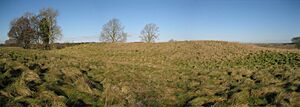White Barrow facts for kids
| Lua error in Module:Location_map at line 416: Malformed coordinates value. | |
| Location | Salisbury Plain, England |
|---|---|
| Coordinates | Lua error in Module:Coordinates at line 614: attempt to index field 'wikibase' (a nil value). |
| Type | Long barrow |
| Length | 77.5 metres (254 ft) |
| Width | 47 metres (154 ft) |
| History | |
| Periods | Neolithic |
| Site notes | |
| Ownership | National Trust |
| Identifiers | |
| NHLE | 1018159 |
White Barrow is a very old burial mound on Salisbury Plain in England. It's called a "long barrow" because of its shape. It was built by people in the Neolithic period, which was a long, long time ago. This special place is protected as a "scheduled monument" and is looked after by the National Trust. It was actually the very first ancient site the National Trust ever bought!
Contents
What is White Barrow?
White Barrow is a huge mound of earth. It is about 77.5 meters (254 feet) long. It is also around 47 meters (154 feet) wide. This measurement includes a ditch that goes all the way around it. People built it between 3500 and 4000 BC. This means it is over 5,500 years old! Other similar mounds are found nearby on Salisbury Plain. There is also a very old place called Robin Hood's Ball. This was a large area where people gathered.
Exploring the Barrow's Secrets
No one has ever fully dug up White Barrow. But some things found there help us guess its age. In 1806, a person who studied old things, Richard Colt Hoare, looked inside the mound. He found dark earth. He thought this might be what was left of a wooden burial room.
In 1997, a special survey was done. It used tools to look underground without digging. This survey found signs of a possible burial room inside the mound. It also found a curved line of holes. These holes might have held wooden posts. They were at the eastern end of the barrow. The survey also found an old path. This path used to cross the site.
White Barrow became a protected "scheduled monument" in 1960. This means it is a very important historical site. It is now against the law to damage it.
How the National Trust Bought White Barrow
White Barrow was the first piece of land the National Trust bought. They bought it just to protect an ancient site. Before this, the National Trust mainly bought open spaces. They also bought old houses and gardens.
The National Trust bought White Barrow in 1909. They also bought about 2.75 acres of land around it. It cost £60, which was a lot of money back then. People helped by giving money to buy it. This is called a "subscription." At that time, the army was buying a lot of land nearby. This land was for training soldiers on Salisbury Plain.
Protecting White Barrow from Badgers
In 1998, a family of seven badgers was living in the barrow. They had dug a home, called a "sett," right into the mound. This could damage the ancient site. So, special permission was given to move them. This permission is called a "badger exclusion licence."
The badgers were carefully encouraged to move. They went to a new home outside the barrow's protected area. After they left, the barrow was covered with a special fence. This fence helps stop animals from digging into it again.
When the badgers were moved, some interesting things were found. These were in the dirt they had dug out. The finds included sharp pieces of stone. These were made by people in the Stone Age. Pieces of pottery from the Neolithic and Bronze Age were also found. There was even part of an antler from a red deer.


